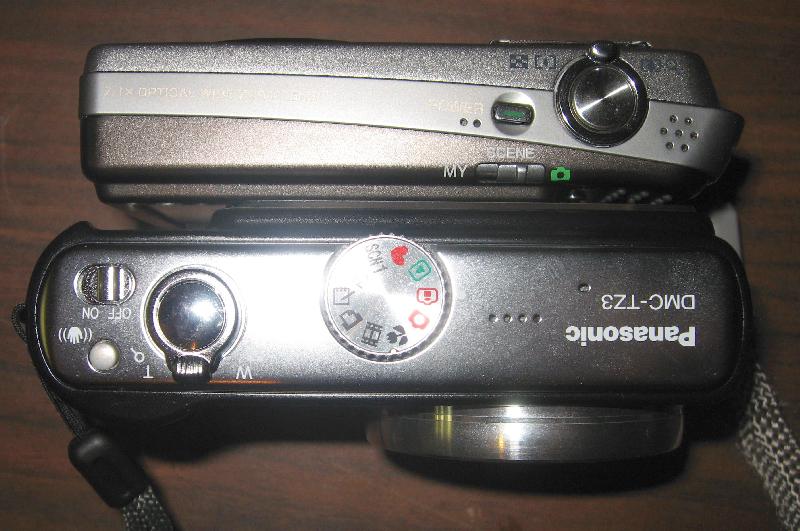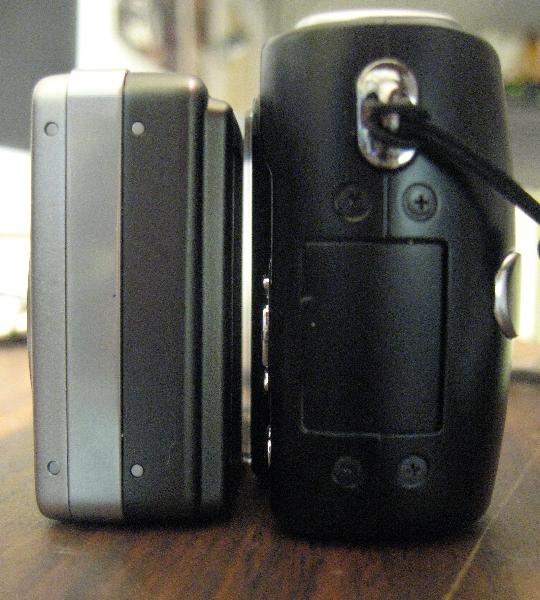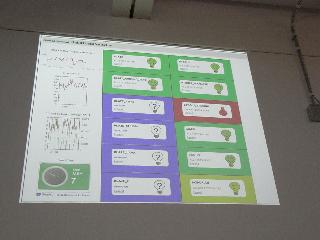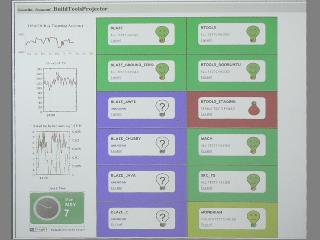| 2007/05/13 Compact Digital Cameras with 7-10x zoom and Panasonic Lumix DMC-TZ3 vs Ricoh Caplio R6 review (and other 7-10x zoom compact cameras) (updated) | |
|
π
2007-05-13 16:40
by Merlin
in Public
I had been waiting patiently for the new crop of compact digital cameras to come out to get a high zoom one as a replacement for my Canon SD550. The Canon was a reasonable camera for its size, but its main problem was that its pretty powerful flash often took up to 10 seconds to recharge, and wouldn't be ready for that first picture after the camera was turned on, giving that very uncomfortable "press the shutter, but no picture, no picture, still no picture" feeling. At the same time, I often found myself wishing that I had a better optical zoom. I ended up waiting until April 2007 to have cameras I could decently choose from (I had spent many hours researching then current cameras in November 2006, and back then, wasn't able to find any option I could live with) Here was my list of requirements for the new camera:
Near requirements:
After some research, contenders were:
Before I start, I'd first like to state my annoyance at apparently what's sometimes a patent problem (I'm going to assume a patent issue more than none of the manufacturers having a clue as to what useful features are), and sometimes apparently the inability of manufacturers to borrow useful features from older cameras from their competitors. As a result, while we should have to chose between camera sizes and picture quality, for cameras that have otherwise similar features, it's instead a struggle between which features you'd really like but you'll have to drop in order to have just a single camera that gets even close to what you'd like. Examples:
This is weird because on the other side, all manufacturers fight to copy one another on fairly useless features (in my opinion) like face recognition. If any of you are reading this, look at the above features first, and look at other features from your competitors that you are free to copy. In the end, I was really left with those two cameras and neither did everything I wanted, but I was hoping one would at least close enough that I could live with it, and it would make a suitable replacement for my Canon SD550. Let's start with a few pictures comparing them:
Now, I need to state that while this is not going to be a professional review and comparison, I did thorough testing for my own use, and I'm sharing the summary of my findings here. While some of you might disagree with a point somewhat, this should still be a useful review and comparison if you're having a hard time deciding between the two cameras, which in my opinion are the only to real contenders for small high zoom cameras with wide angle. Ricoh Caplio R6I'll start with the Ricoh Caplio R6. While it doesn't look much smaller, it actually is noticeably smaller when you're carrying it (it fits in my canon SD550 belt pouch, where the TZ3 doesn't come close). I also liked the good old Ricoh resolution downsize digital zoom. Along with a 7x optical zoom, if you accept to scale your picture down to 640x480, about 7 times smaller resolution-wise, you end up with up to 45x zoom for a VGA sized picture. Now, in real life, I found that the details on those 45x pictures, usually aren't that sharp, and that the camera sometimes has a hard time focussing in those conditions, but it's still a nice feature. The R6 uses a similar resolution downsize trick to give you some kind of zoom during videos, still yielding a stable 640x480 picture. The zoom is however jerky and only gives you 3x. It's not great, but understandable considering the optical zoom is pretty noisy. I also need to note that it does a good job of changing the light exposure if you move the camera from a dark spot to a bright one while filming (my canons wouldn't do that) What's a bit awkward is that the R6 tries to do without a rolling selector button, but has to hide some functions in menus and submenus instead. You can't easily switch from 100 Iso to high iso mode by just rolling a switch (although the preset setting option might help a bit here). What's more awkward is that to record a movie, you have to go in scene mode and select the movie scene. The R6, while doing without a rolling selector button, however does have a button that you can program settings on: it's a nice idea. As far as scene modes, it doesn't have many, but then again, I personally couldn't care less about scene modes. As far as I am concerned, scene modes are only presets for people who don't know how to set their preferred manual settings for each kind of shot. One nice preset however is the option to take a slide or a poster from an angle, have the camera detect the trapezoid, and fix it back to a rectangle.
More generally, the camera can take any previously taken picture and fix it after the fact. It's slow for a 7Mpix picture (about 30 seconds), but it works remarkably well. From the few tests I've done, in low light situations, the R6 seems be a bit less noisy than the TZ3, and its flash seemed decent. It takes around 5 seconds to recharge. You can find the low light pictures here For night pictures, it can take pictures with a 1 to 8 second shutter time, which is ok for most shots, although not quite enough for very low light situations (night sky). You can see night pictures here The R6 is like other Ricohs, nice for its manual focus option, and very good macro capability. Last, but not least, the R6 has a novel fast shot mode where it can capture 16 800x600 shots at high speed and make one picture out of it, or (better), take high speed pictures for as long as you press the shutter, and it'll keep the last 16 shots and make one pictures out of it (perfect for when you're waiting for sommeone to jump or some event to start). See this picture for an example of what it looks like The first negative point for me is that Ricoh did not seem fit to put an image orientation sensor in the camera. I'm sorry, but I stopped rotating pictures by hand on my computer years ago. Get with the program Ricoh... However, another problem that made me uncomfortable with the camera was the fact that I got some blurry pictures in full daylight. It only happened a few times, I can't tell you why, but here's an example: 102_Bad_R6_Picts_100iso_0.0023s_noflash (sorry, it was inconvenient to go back in a plane and try some other settings after the fact That said, most pictures were good thankfully, see more day pictures . If you would like a longer review, you can read this other Ricoh Caplio R6 and a list of specs SummaryPros:
Cons:
Panasonic DMZ TZ3First, I've stated earlier, the TZ3 is unfortunately noticeably bigger than the R6. After having a canon SD550 on my belt for a while, switching to the R6 wasn't bad, but switching to the TZ3 definitely makes my belt pouch bigger. Unfortunately, the batteries' form factor doesn't help, they are much thicker than wide, making your belt pouch even thicker as a result (usually the batteries sit in front of the camera in most belt pouches) The absence of viewfinder is a problem when the camera freezes its picture while trying to auto focus on a moving object. I tried to take pictures of moving birds at full zoom, the picture froze for several seconds while the camera was trying to focus, and I entirely lost my moving subject and the pictures as a result. I would have been happy with a simple viewfinder with an aiming cross, even if it didn't go through the lens. Update : there is continuous autofocus option doesn't prevent freezes altogether, but may help. The other gotcha is some autofocus modes are actually documented to freeze the picture (notably the H 3 area focus mode, while the 9 point mode doesn't seem to hang much or at all). I still miss the viewfinder, but it makes its absence more bearable. It's also sad that the LCD is of questionable quality. It needs a special mode to be visible from high angles (i.e. holding the camera above your head) where the R6 and canon LCDs just work all the time from all angles. Overall, the TZ3 LCD just didn't seem as good compared to the other ones I've used. It's usable enough though. I'm disappointed that the camera doesn't let you zoom at all during movies. They should really have allowed use of the very quiet optical zoom, or at least some digital resolution based zoom. For night pictures, while the camera did somewhat decent shots, but forces you to select specific night scene modes depending on the shutter speed you want (that's unfortunate and non intuitive). Once you figured out how to use the scene modes, you can get decent night pictures and long shutter modes of 15 to 60 seconds allow for quite nice night pictures . During low light situations, the 200 to 800 ISO modes are usable, but somewhat noisy and clearly more noisy than the R6 as you can see in this picture gallery . All this said, the 10x optical zoom is good, and you can get up to 15x if you are willing to downgrade your resolution to 3Mpix, but it's awkward: you can't just keep zooming in like you can on the R6. Picture quality at 10x zoom is pretty good for a camera this size though, you can check them out . For that matter, I didn't take any pictures outside where the lighting was all wrong, or the picture blurry. Flash pictures looked ok, and the flash also recharges in about 5 seconds. The camera makes that fact clear by turning the screen off, likely to divert more power to the flash. It's both a nice idea, but also a bit annoying when you're trying to keep a subject in your screen on a camera that doesn't have a viewfinder. A few other random noteworthy things about the camera: it has a nice dual picture review mode (where you can view side by side any two pictures you took, and compare them), it has an exposure bracketing mode where it'll take 3 pictures at different EV values and leave you with hopefully one good one, it has a clipboard which is basically an internal memory for a few low res pictures like maybe road signs, or a map you saw on a wall, and it can extract a single picture from a movie (although at a silly 1920x1080 resolution that is about 6x bigger than the actual frame resolution and is therefore digitally blown up), but it has a nicer option to create a picture with 9 frames of a movie to show a stop motion scene. The last important thing you need to be aware of: my original review listed several things that I thought the camera couldn't do because those options were absent in the list of manual options. It turns out that Panasonic has unfortunately decided that some of the options would only be available in the scene modes. You need to use a scene mode to:
If you would like a longer review, you can read this Panasonic Lumix DMC-TZ2 and DMC-TZ3 dpreview / Panasonic Lumix DMC-TZ3 dcrp review and list of specs , list of specs2 SummaryPros:
Cons:
First, feel free to review all the comparative pictures I've taken on them, you can decide for yourself. The batteries on the DMC are a bit bigger, but don't last any longer. Considering that the Ricoh R6 actually ships with a battery smaller than the slot it can fit in and comes with larger upgrades, it should have better battery life than the DMC TZ3 with an extended battery. The Ricoh's high ISO pictures looked a bit better overall. Macro pictures were slightly better on the R6, but the TZ3 was a close enough second so that both will work fine for your typical macro pictures. I liked the rolling selector on the TZ3, it was quicker to select options on the TZ3 than the R6 with fewer buttons. While both cameras had a quick picture review option, the R6 would not show the shutter speed or the ISO after a picture was taken. I found this to be a problem when taking pictures in auto-hi ISO mode, and not knowing how high the ISO had been pushed. As already mentioned the zoom is a bit better on the TZ3, but the camera is also larger. Now, coming to image quality, I wish I had more details to give you, I'm not saying that pictures taken from the Ricoh R6 are routinely bad, I'm just saying that I saw a few pictures that worried me: A picture taken indoors close to the subject in a well lit environment with flash, cannot be blurry. If I take two such pictures in a row, and they are both blurry, that is a problem. A few outside pictures that were blurry for no good reason that I could find also worried me. I'm not a professional photographer, but I've taken about 40,000 digital pictures in the last 8 years, and rarely in the automatic mode. I can't promise that I didn't do anything wrong with the R6, but at least I gave it my best shot and I felt it let me down a few times where it shouldn't have. I really wanted to have liked the Caplio R6, for its size and its cool features, but first the lack of orientation sensor, and then those few pictures of questionable quality, were enough to turn me off (I also couldn't find a diving/underwater housing for it, although one may show up sooner or later, there was none that I could find). While it's true that the camera is bigger, I feel that the pictures were a little bit better, especially in high zoom situations, and call me silly but I didn't want to rotate my pictures by hand. Sorry Ricoh, but that's your fault. I still think that both cameras are the best choices today. If you can live without an orientation sensor, and aren't as picky as me on picture quality in all cases (I've had canons for many years, and they were slow to take pictures, they got me used to good pictures, even from a small camera), the Ricoh Caplio R6 is a nice camera with a very good zoom for its size. Now, if you want a diving housing, auto-rotated pictures, a 10X zoom instead of 7x, and pretty good picture quality for its size, then the Panasonic DMC TZ3 is likely what you want. I hope this helps you, good luck finding the right camera for you, and feel free to tell your salespeople from Ricoh/Panasonic/Canon other what features you'd like and what they're missing. While I can't help you with your individual camera, if you have found factual errors or clear omissions in this page, feel free to contact me (you can also send me a quick thanks if the 10 or so hours I spent on it were useful to you and link to this page if you think it'll be useful to others) |




